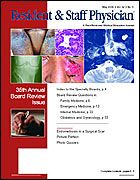Publication
Article
Resident & Staff Physician®
Emergency Medicine Quiz: Can you diagnose the cause of this patient's abdominal pain?
Prepared by Christopher L. Stout, MD, PGY 5, Chief Surgical Resident, Department of Surgery, Medical Center of Central Georgia, Macon; Amy B. Moore, MD, PGY 2, Surgical Resident, Department of Surgery, Medical Center of Central Georgia, Macon; and Thomas Woodyard, MD, General Surgery Private Practice, Macon, GA
CASE REPORT
A 58-year-old man presented to the hospital because of a 6-hour history of sharp, nonradiating abdominal pain that worsened upon movement. He had never experienced such pain before and had no significant medical history. The patient reported no fever, chills, nausea, vomiting, or diarrhea. His vital signs were normal, but his abdomen was tender to palpation. Laboratory examinations were normal. Abdominal and pelvic computed tomography scans using intravenous and oral contrast were obtained (Figures below). The patient developed peritonitis and a surgical consultation was obtained.
What's your diagnosis?
- Focal Crohn's disease
- Small bowel neoplasm
- Perforated jejunal diverticulitis
- Perforated Meckel's diverticulum
Read the Answer
Answer
DIAGNOSIS: Perforated jejunal diverticulitis
Abnormal peristalsis and elevated intraluminal pressures are thought to cause multiple false diverticula on the mesenteric side of the bowel; this condition is known as jejunal diverticulosis.1,2 Autopsy series indicate an incidence of approximately 0.5%.3 Perforation and diverticulitis are the most common complications of jejunal diverticula.3,4 Other complications include obstruction, hemorrhage, and bacterial overgrowth.
Figure-Axial CT scans at 5-mm sections showing mesenteric inflammation (white arrows; A and B), intermesenteric air (arrowhead; A), and an outpocketing (blue arrow; A).
Perforated jejunal diverticulitis is difficult to diagnose because perforations are contained between the leaves of the mesentery. Patients often present with a history of sudden and focal abdominal pain that occasionally progresses to diffuse constant pain associated with nausea, vomiting, and fever or chills. Physical examination is significant for localized abdominal tenderness to palpation and decreased bowel sounds on auscultation. Diffuse abdominal rigidity is a late manifestation of a contained perforation and mandates immediate surgical exploration. The patient's white blood cell count is sometimes elevated and demonstrates a left shift. Abdominal radiographs rarely show free air. Abdominal and pelvic computed tomography (CT) scanning is the best diagnostic modality, demonstrating focal areas of thickening, mesenteric inflammation, and outpocketings.5 Our patient's CT scans at 5-mm sections in the axial plane demonstrated mesenteric inflammation, intermesenteric air, and an outpocketing (Figures). No free fluid or air was visible in the peritoneal cavity, excluding other sites of a perforated viscus. A diagnosis of perforated jejunal diverticulitis was made, which was confirmed during exploratory laparotomy. Segmental small bowel resection with primary anastomosis was performed; this is the preferred surgical treatment for small bowel perforation, except for colonic diseases that require an ostomy. A laparoscopic approach is an alternative for experienced surgeons.
In contrast to jejunal diverticulitis, symptoms of small bowel neoplasms develop gradually and are usually obstructive, but perforation is possible. Physical examination and CT scan findings, especially of lymphomas and focal Crohn's disease, are difficult to differentiate, but are usually segmental and not diffuse like small bowel diverticulitis.6
Meckel's diverticulum results from incomplete obliteration of the vitelline duct during fetal development. Its presentation is similar to that of jejunal diverticula, but the diverticulum arises from the antimesenteric side of the small bowel. Like perforated colonic diverticulitis, a perforated Meckel's diverticulum perforates into the intraperitoneal space. Diverticulosis of the small bowel is usually diffuse and easily seen on CT scanning. In most cases, only one diverticulum is perforated. Surgical resection and anastomosis is the treatment of choice for the inflamed and perforated segment of small bowel, and any normal appearing diverticula should be left alone. The proximal location of small bowel diverticula precludes use of an ostomy, which could prove detrimental and result in malnutrition, especially in the elderly.
DISCLOSURE
The authors have no relationship with any commercial entity that might represent a conflict of interest with the content of this article and attest that the data meet the requirements for informed consent and for the Institutional Review Boards.
REFERENCES
- Rankin FW, Martin WJ Jr. Diverticula of the small bowel. Ann Surg. 1934;100:1123-1135.
- Vantrappen G, Janssens J, Hellemans J, et al. The interdigestive motor complex of normal subjects and patients with bacterial overgrowth of the small intestine. J Clin Invest. 1977;59:1158-1166.
- Sibille A, Willcox R. Jejunal diverticulitis. Am J Gastroenterol. 1992;87:655-658.
- Donald JW. Major complications of small bowel diverticula. Ann Surg. 1979;190:183-188.
- Gotian A, Katz S. Jejunal diverticulitis with localized perforation and intramesenteric abscess. Am J Gastroenterol. 1998;93:1173-1176.
- Macari M, Faust M, Liang H, et al. CT of jejunal diverticulitis: imaging findings, differential diagnosis, and clinical management. Clin Rad. 2007;62:73-77.
